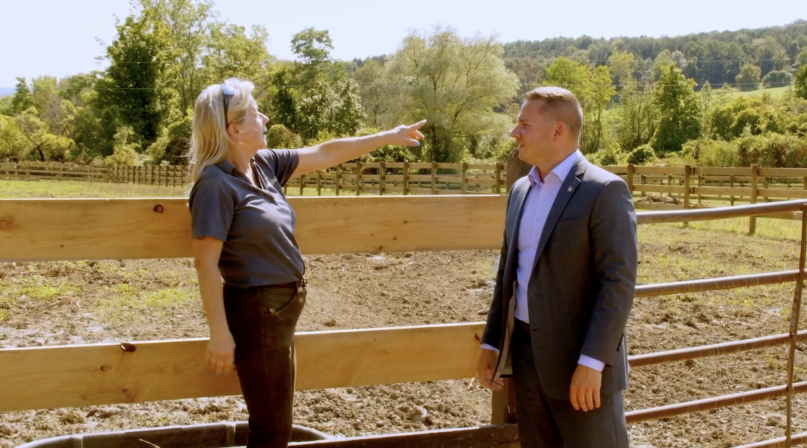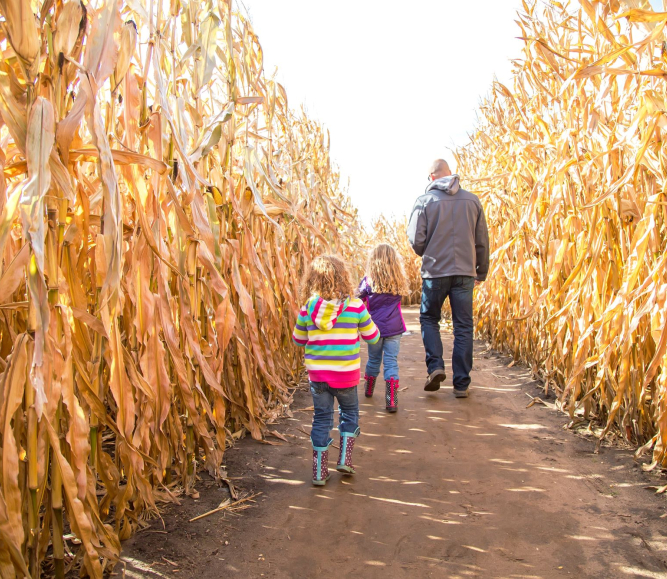Agritourism helps boost rural counties

Farmers used to look forward to rain. Now, they hope for a steady stream of visitors.
As the bulk of food production shifts away from them and toward corporate agriculture, small- and medium-sized farms are diversifying their business models, aiming to share the rural experience with neighbors and use their land in new ways.
That means hayrides, corn mazes, farmers markets or a chance to pick your own apples, pumpkins or berries. In the middle of the country, large properties play host to hunting retreats and dude ranches. When looking for a wedding venue, couples increasingly seek out barns for their ceremonies and receptions.
“It’s pretty amazing what some farmers and ranchers have been able to pull off to stay viable and keep farms and ranches running when all other economic indicators would suggest there are higher uses for that land and water,” said Dawn Thilmany, an agricultural economist and professor at Colorado State University. “It’s really great to see some people keeping it in agriculture.”
Learn more
Zoning remains a challenge for counties managing agritourism
Agritourism was a $1.26 billion business in 2022, representing 1.5% of domestic agricultural operations among 28,617 farms, according to the most recent Census of Agriculture, released in February by the Department of Agriculture. Those measures, Thilmany said, severely undercount the sector’s economic impact. She estimates it may be closer to $13 billion a year, because of a combination of inconsistent data collection, misconceptions about what qualifies as an agritourism business and insurance issues.
“We’re trying to track the apples-to-apples, but we don’t believe the definition has been consistent enough,” she said.
Those complications have also made it hard to compare the sector’s growth over the years, because each Census of Agriculture, compiled every five years, defines terms differently. The two most recent censuses, for example, did not include wineries in their totals.
USDA found 29% of farms reporting agritourism income took in between $1,000-$5,000 and 23% earned more than $25,000.
“We know it also under-captures all of those ripple effects of tourism,” she said. “If people come out to go see wine country, they’re going to stay at hotels nearby, they’re going to go to restaurants nearby, but that isn’t measured consistently.”
If it seems like a growing number of wedding photos feature distressed wood and pastoral backdrops, your friends and family are likely trendsetters. According to The Knot’s 2023 Real Weddings Study, farms, barns and ranches were selected most often (chosen by 17% of couples) as the venue choice for the ceremony and the second most popular choice (chosen by 18% of couples) for the reception venue, behind banquet halls (chosen by 20% of couples).
Also left unmeasured are the local employment impacts, with expanded operations opening the door to local hiring.
Counties can support their local agritourism efforts financially and programmatically. Onondaga County, N.Y. identified support for agritourism as a priority after revising its comprehensive plan and has issued grants to 53 farms through a competitive process, awarding a total of $790,000 in 2024.
“We asked, ‘How do we create an agritourism trail that we can market broadly?’” said County Executive Ryan McMahon. “You need viable businesses that have something worth marketing and these tourism grants have certainly helped with that.”
The skill that made farmers successful, he said, applies beyond the practice of agriculture.
“I don’t think people look at farms as small businesses,” McMahon noted. “You see the innovation, the efficiencies that these farms have gone through in losing some of their most valuable workforce. There are a lot of kids who aren’t doing what their parents did. Family farms are struggling, particularly dairy farming, so how do you diversify your offerings? And I think many of our different farms have done that.”
McMahon said the presence of a robust agritourism environment makes a region more attractive to potential residents of all ages.
“You develop, recruit and retain a workforce, and entertainment infrastructure is a part of that,” he said. “Families need things to do, your workforce needs something enjoyable to do on their days off, and in our case, you can go to Crazy Daisies or 1911,” referring to a family farm and a distillery in Onondaga County.
“You’ll see kids playing with parents and you’ll have 20-somethings having drinks and dinner with their friends. I think ag tourism helps strengthen communities from a retention standpoint and it certainly helps make you a more interesting community to market.”
The kind of agritourism that succeeds in different areas depends on the proximity to urban areas and infrastructure, with urban “collar counties” showing success. If they’re located more than an hour or two from population centers, agricultural businesses can suffer when lodging options don’t match visitors’ needs. Hunting getaways, on the other hand, thrive on the remoteness, and cater to smaller groups., and those properties are typically relegated to 12 states in the Great Plains, Mountain West and Texas.
Farmers are just as excited to offer a look at the agricultural lifestyle as customers are to immerse themselves. David Morgan is planning to turn his passion into an agricultural experience. A first-generation farmer, Morgan got into regenerative agriculture to ensure the integrity of the food his family ate. Seven years later, he’s managed to hold his own selling livestock because he is not at a disadvantage buying feed because his family grows it on his Lawrence County, Tenn. farm. He is now the county executive,
An hour-and-a-half from the Washington, D.C. and Baltimore areas, Washington County, Md. employs a business specialist for agriculture in its Business and Economic Development Office. Kelsey Keadle spent her first month on the job meeting with farmers in the county and learning about how they’d like to grow their businesses. Like Morgan, local farmers voiced a desire to enter the short-term rental market, this time with camping sites, which were recently first allowed by state law and local ordinance.
“A local farmer was trying to put a couple small cabins on his land, and he had the drawings all done up and everything, until it came to the community hearing for it,” Keadle said. “That’s when there was so much pushback, so that killed the whole idea right then and there.”
Keadle sees the most consistent impact of her role coming as a liaison between farmers and businesses that could carry local produce and helping them conform to local regulations. That kind of work is increasingly prized, because a Penn State University study found that zoning and permitting were significant obstacles in agritourism operators’ daily operations, and the operators sought more assistance from local officials to understand the complexities of these rules.
“I’m doing whatever I can to help farmers with additional income, particularly in the winter, such as with our Groundhog Day celebration in February,” she said, naming an indoor event that showcases local producers and vendors. “Whatever we can do to highlight our agriculture.”
Related News
Rural housing affordability approaches crisis
Policy solutions mentioned in the national discussion on housing affordability often pose a mismatch with the conditions on the ground in rural counties.

Congress introduces bipartisan legislation to strengthen rural health care access and funding
Rural communities face unique health care challenges, from provider shortages to funding disparities. To address these concerns, the U.S. Senate recently introduced two bipartisan bills aimed at improving rural health care access and funding: the Rural Health Focus Act and the Fair Funding for Rural Hospitals Act.
County News
Counties hurdle zoning challenges for agritourism


